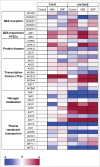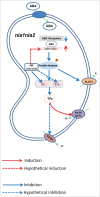Loss of nitrate reductases NIA1 and NIA2 impairs stomatal closure by altering genes of core ABA signaling components in Arabidopsis
- PMID: 27171851
- PMCID: PMC4973779
- DOI: 10.1080/15592324.2016.1183088
Loss of nitrate reductases NIA1 and NIA2 impairs stomatal closure by altering genes of core ABA signaling components in Arabidopsis
Erratum in
- Addendum to: Chen ZH, Wang Y, Wang JW, Babla M, Zhao C, García-Mata C, Sani E, Differ C, Mak M, Hills A, Amtmann A, Blatt M.R. Nitrate reductase mutation alters potassium nutrition as well as nitric oxide-mediated control of guard cell ion channels in Arabidopsis. New Phytol 2016; 209:1456–69, DOI: 10.1111/nph.13714.
Abstract
Nitrate reductases NIA1 and NIA2 determine NO production in plants and are critical to abscisic acid (ABA)-induced stomatal closure. However, the role for NIA1 and NIA2 in ABA signaling has not been paid much attention in nitrate reductase loss-of-function mutant nia1nia2. Recently, we have demonstrated that ABA-inhibited K(+)in current and ABA-enhanced slow anion current were absent in nia1nia2. Exogenous NO restored regulation of these channels for stomatal closure in nia1nia2. In this study, we found that mutating NIA1 and NIA2 impaired nearly all the key components of guard cell ABA signaling pathway in Arabidopsis. We also propose a simplified model for ABA signaling in the nia1nia2 mutant.
Keywords: Abscisic acid; gene expression; guard cell; nitric oxide; signaling transduction.
Figures


Similar articles
-
Nitrate reductase mutation alters potassium nutrition as well as nitric oxide-mediated control of guard cell ion channels in Arabidopsis.New Phytol. 2016 Mar;209(4):1456-69. doi: 10.1111/nph.13714. Epub 2015 Oct 28. New Phytol. 2016. PMID: 26508536
-
Nia1 and Nia2 are involved in exogenous salicylic acid-induced nitric oxide generation and stomatal closure in Arabidopsis.J Integr Plant Biol. 2010 Mar;52(3):298-307. doi: 10.1111/j.1744-7909.2010.00920.x. J Integr Plant Biol. 2010. PMID: 20377690
-
A new role for an old enzyme: nitrate reductase-mediated nitric oxide generation is required for abscisic acid-induced stomatal closure in Arabidopsis thaliana.Proc Natl Acad Sci U S A. 2002 Dec 10;99(25):16314-8. doi: 10.1073/pnas.252461999. Epub 2002 Nov 21. Proc Natl Acad Sci U S A. 2002. PMID: 12446847 Free PMC article.
-
Nitric oxide, stomatal closure, and abiotic stress.J Exp Bot. 2008;59(2):165-76. doi: 10.1093/jxb/erm293. J Exp Bot. 2008. PMID: 18332225 Review.
-
Signaling Transduction of ABA, ROS, and Ca2+ in Plant Stomatal Closure in Response to Drought.Int J Mol Sci. 2022 Nov 26;23(23):14824. doi: 10.3390/ijms232314824. Int J Mol Sci. 2022. PMID: 36499153 Free PMC article. Review.
Cited by
-
Nitric oxide molecular targets: reprogramming plant development upon stress.J Exp Bot. 2019 Aug 29;70(17):4441-4460. doi: 10.1093/jxb/erz339. J Exp Bot. 2019. PMID: 31327004 Free PMC article. Review.
-
Nitric Oxide and Melatonin Cross Talk on Photosynthetic Machinery.Molecules. 2025 May 13;30(10):2148. doi: 10.3390/molecules30102148. Molecules. 2025. PMID: 40430320 Free PMC article. Review.
-
Nitric Oxide: Its Generation and Interactions with Other Reactive Signaling Compounds.Plants (Basel). 2019 Feb 12;8(2):41. doi: 10.3390/plants8020041. Plants (Basel). 2019. PMID: 30759823 Free PMC article. Review.
-
Fast-track transformation and genome editing in Brachypodium distachyon.Plant Methods. 2023 Mar 29;19(1):31. doi: 10.1186/s13007-023-01005-1. Plant Methods. 2023. PMID: 36991448 Free PMC article.
-
Update on roles of nitric oxide in regulating stomatal closure.Plant Signal Behav. 2019;14(10):e1649569. doi: 10.1080/15592324.2019.1649569. Epub 2019 Aug 1. Plant Signal Behav. 2019. PMID: 31370725 Free PMC article. Review.
References
-
- Cutler SR, Rodriguez PL, Finkelstein RR, Abrams SR. Abscisic acid:emergence of a core signalling network. Ann Rev Plant Biol 2010; 61:651-79; PMID:20192755; http://dx.doi.org/1940714210.1146/annurev-arplant-042809-112122 - DOI - PubMed
-
- Ma Y, Szostkiewicz I, Korte A, Moes D, Yang Y, Christmann A, Grill E. Regulators of PP2C phosphatase activity function as abscisic acid sensors. Science 2009; 324:1064-8; PMID:22645333; http://dx.doi.org/1940714210.1073/pnas.1203567109 - DOI - PubMed
-
- Park SY, Fung P, Nishimura N, Jensen DR, Fujii H, Zhao Y, Lumba S, Santiago J, Rodrigues A, Chow TF, et al.. Abscisic acid inhibits type 2C protein phosphatases via the PYR/PYL family of START proteins. Science 2009; 324:1068-71; PMID:19407142; http://dx.doi.org/10.1126/science.1173041 - DOI - PMC - PubMed
Publication types
MeSH terms
Substances
LinkOut - more resources
Full Text Sources
Other Literature Sources
Molecular Biology Databases
